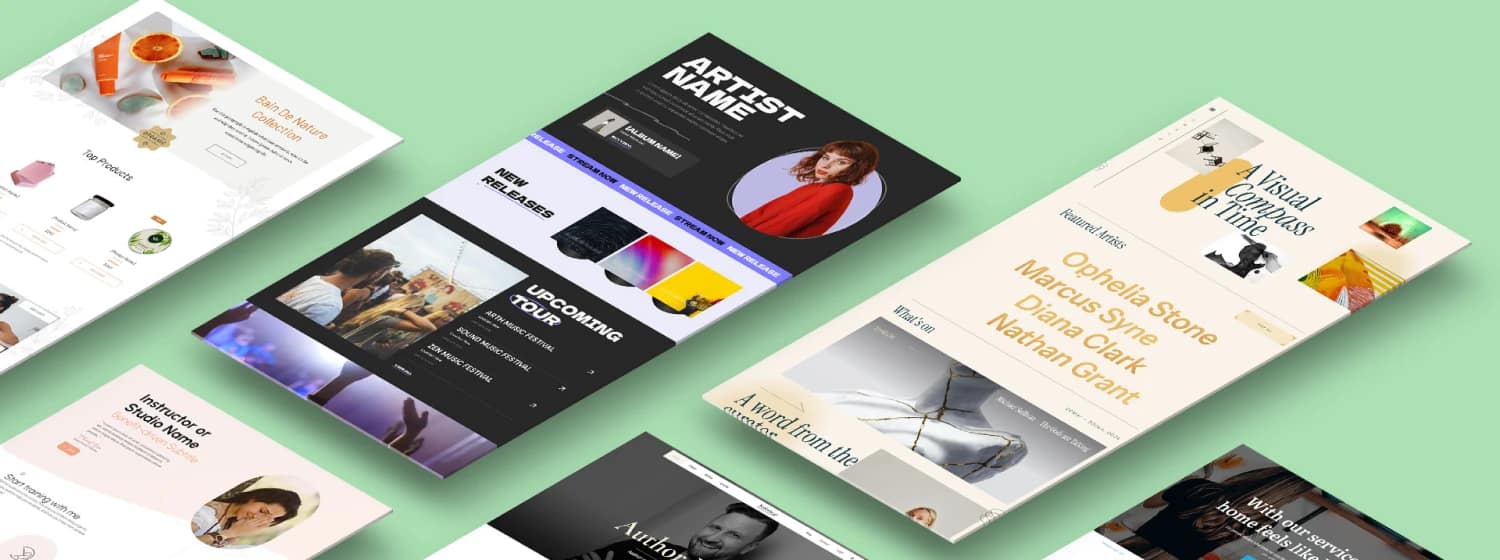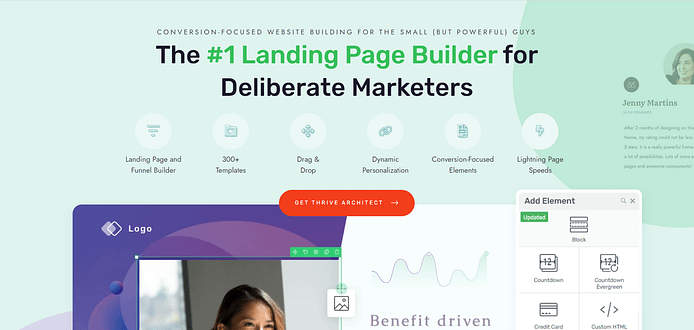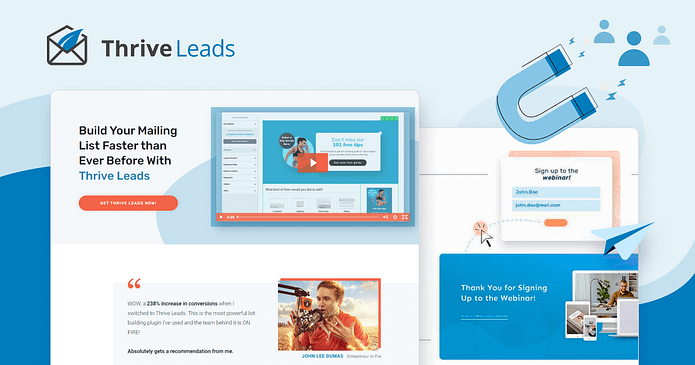TL;DR The Fastest Way to Improve Funnel Conversion Rates (2025)
If you’re trying to figure out how to improve your funnel conversion rates, here’s the short version:
Most funnels underperform because of friction, unclear messaging, missing micro-conversion data, or weak post-purchase journeys. When you tighten each stage and remove hesitation, your conversion rates rise—without buying more traffic.
3 Key Takeaways
- Know your benchmarks. Compare your funnel to 2025 industry averages so you instantly see where drop-offs are happening.
- Fix friction before traffic. Improve mobile UX, simplify steps, shorten forms, and streamline your message.
- Test everything. A/B testing headlines, offers, layouts, and CTAs gives you compounding gains—especially when combined with first-party data and personalization tools.
If you’re a skimmer, this is your cue to keep reading. Improving funnel conversion rates is one of the highest-ROI upgrades you can make to your entire business.
You don’t have a traffic problem — you have a conversion leak.
I know how that feels. You’re watching people land on your page, poke around, maybe even scroll all the way down… and then vanish. Ninety-five out of a hundred, gone. No sale, no signup, no second look.
The numbers don't lie: Most funnels convert just 3% of visitors. That means 97 out of every 100 people are bouncing without buying, signing up, or sticking around.
Not because your offer is bad. Not because your copy missed the mark. Somewhere between curiosity and commitment, something small pushed them away — a bit of friction, a missing nudge, a moment of hesitation that went unresolved.
I’ve seen it in my own funnels and in dozens of others. It’s frustrating, but it’s also fixable — once you know where the leaks are.
That’s what this guide is about. Not throwing random tactics at the problem, but tracing your funnel stage by stage until you spot the weak link that’s costing you conversions. Then you can fix it with intention, not panic edits and endless A/B tests that don’t move the needle.
Let’s start there — with clarity, not guesswork.
🔍 Key Takeaways
- Funnel optimization starts with diagnosis. You can’t fix what you don’t measure — find your leaks before you tweak.
- Know your benchmarks. Median landing page conversion rates hover around 4.3% (Unbounce), so if you’re below that, you’re not alone.
- Go beyond design. Use behavioral data, advanced tactics like conditional display, and trust triggers to improve real user experience.
- Trust wins conversions. Social proof, transparency, and strong guarantees turn hesitation into confidence.
What Is a Good Funnel Conversion Rate? (2025 Benchmarks)
Before you can improve your funnel, you need to know what “good” actually looks like. Funnel performance varies wildly depending on your industry, traffic quality, and offer — but recent industry reports (including VWO and other market analyses) provide reliable benchmark ranges you can measure yourself against.
Here’s how average conversion rates typically break down across a standard B2B/B2C acquisition funnel:
2025 Average Funnel Conversion Rates
| Funnel Stage | Average Conversion Rate |
|---|---|
| Website Visitor → Lead | **1% – 5%** |
| Lead → Marketing Qualified Lead (MQL) | **25% – 35%** |
| MQL → Sales Qualified Lead (SQL) | **13% – 26%** |
| SQL → Opportunity | **50% – 62%** |
| Opportunity → Closed-Won Customer | **15% – 30%** |
Takeaway: If you see a major drop-off at any stage compared to these benchmarks, that’s your highest-leverage optimization point. Fixing one weak stage can dramatically increase your overall funnel conversion rates without adding more traffic.
The Key to Improving Your Conversion Funnels: Go Beyond the Basics
I remember one of the first funnels I ever built. I followed every so-called best practice I could find — compelling headline, short form, bright CTA button. I launched it, crossed my fingers… and barely anyone converted.
It felt like I’d done everything right. The results, however, said otherwise.
Turns out, I wasn’t alone. According to Unbounce, most landing pages convert below 5%, and the top 10% only hit around 11%. That means even good funnels leave a lot of opportunity on the table.
And here’s what I’ve learned since: good enough isn’t good enough anymore.
Your visitors have seen a hundred generic pages this week. They scroll fast, judge faster, and don’t give second chances.
That’s why improving your funnel means going beyond basic design tweaks and leaning into strategies that challenge the usual playbook. Some are simple, others are strategic — but they all work.
Before you try to fix any one metric, it helps to zoom out and look at the full buyer’s journey so you can see where your funnel is actually breaking.
Key Funnel Optimization Trends in 2025
Digital marketing is evolving fast, and funnel optimization is evolving along with it. These three trends are shaping how high-performing businesses convert in 2025:
1. AI-Powered Personalization
AI tools now make it possible to deliver one-to-one experiences at scale:
The more tailored the journey, the less friction users experience — and the higher your conversion rates climb.
2. Privacy-First Analytics (Beyond Cookies)
With the decline of third-party cookies, analytics is shifting toward:
Funnels now need to be built with data integrity in mind.
3. Conversational Marketing
Chatbots, human live chat, and hybrid assistants now play a key role at the *consideration* and *decision* stages.
They can:
Adding conversational elements to your funnel removes pressure from your copy and gives users instant support.
13 Ways to Improve Your Funnel Conversion Rates
Now trust me when I say I know there’s a lot of noise out there about conversion optimization. I read through a lot of it. Some of it’s helpful. Most of it’s just recycled fluff.
So instead of overwhelming you with a massive list of “hacks,” I’ve pulled together 13 strategies that are actually worth your time. These are the tactics I’ve seen work in real funnels—for real businesses—with limited time and resources.
They’re practical, punchy, and (mostly) quick to implement. Whether your funnel is brand new or on its tenth round of edits, these ideas can help you spot what’s missing and start turning more clicks into customers.
Let’s get into it.
A Quick Recap: The 4 Key Stages of Your Conversion Funnel
Before we jump into the strategies, here’s a quick refresher on how a typical marketing funnel works:
- Awareness (Top of Funnel): This is where people discover you—through blog posts, ads, social media, search engines. Your goal here is to attract the right kind of attention.
- Consideration (Middle of Funnel): At this stage, people are exploring whether your offer is a good fit. Your job is to build trust, provide value, and make their decision easier.
- Decision (Bottom of Funnel): They’re close to buying—but friction, doubt, or bad timing can still stop them. This is where smart tactics can seal the deal.
- Post-purchase: The funnel doesn’t stop after a sale. A strong post-purchase experience builds loyalty, increases lifetime value, and leads to referrals.
Now that we’re on the same page, let’s get into the strategies—sorted by stage so you can focus on what your funnel really needs right now.
If you’re still getting comfortable with funnel terminology, this Sales Funnel 101 guide walks through each piece in plain English.
🛠️ Foundational Tactics That Apply to Every Stage
These are the behind-the-scenes moves that support your funnel from top to bottom. If your funnel feels “off,” start here.
1. Start with a Data Audit to Find Your Biggest Leaks
“You can’t fix what you don’t know is broken.”
Before changing anything, you need to identify the real problem areas. You might think your landing page is the issue — but analytics will tell you whether it’s actually the traffic source, offer alignment, or timing.
At Thrive, we always start with the data. Tools like MonsterInsights
I use MonsterInsights to get a clear picture of my site's performance. It integrates directly with Google Analytics, showing clear, actionable metrics right in your WordPress dashboard.
Key metrics to review:
- Traffic sources: Which channels bring in the most engaged visitors?
- Bounce rate: Where are people dropping off immediately?
- Conversion rate: How many take the desired action at each stage?
- Exit pages: Which page makes people leave most often?
- User flow: Are visitors following your intended path or getting lost?
Once you’ve mapped your weak points, you’ll know where to focus your fixes — instead of guessing.
Benchmark for context:
Most B2B funnels convert only a small portion of leads. If your numbers fall near these ranges, you’re within normal limits.
Typical B2B Funnel Conversion Rate Benchmarks
Funnel Stage Transition | Typical B2B Conversion Rate Benchmark |
|---|---|
Lead → MQL (Marketing Qualified Lead) | 25% – 35% |
MQL → SQL (Sales Qualified Lead) | 13% – 26% |
SQL → Opportunity | 50% – 62% |
Opportunity → Closed Deal | 15% – 30% |
Source: Adapted from Hibob Industry Data
Many ‘conversion problems’ are just basic layout issues — this breakdown of common landing page mistakes can help you spot quick wins.
2. Use Better Tools to Build Your Conversion Funnel
There’s a point where “making do” with free tools starts costing more than it saves. Not just in money — in time, energy, and missed opportunities.
If you’re running a business, your funnel isn’t just a set of pages. It’s how people experience your brand, build trust, and decide to buy. The tools you use should make that process smoother — not something you fight with every time you want to update a headline or test a new offer.
That’s why I build in Thrive Architect. It gives me the control and clarity I need to turn ideas into pages that actually convert — without hiring a developer or spending hours figuring out tech.
Here’s what that means for you:
- You move faster. Launch new pages, test ideas, and make updates on your own terms.
- You stay focused on results. Every element — from timers to testimonials — is built to nudge visitors closer to “yes.”
- You speak directly to your audience. Conditional Display lets you show the right message to the right person at the right time.
- You build with confidence. Clean, consistent design without the stress of coding or compatibility headaches.
If you’re wondering which funnel structure makes the most sense for your offer, this library of sales funnel types gives you proven models to copy.
The goal isn’t to have the fanciest funnel — it’s to have one that works hard for your business while you focus on the bigger picture.
🎯 Awareness Stage: Get the Right People Through the Door
At this stage, your job is to attract and qualify attention—not just get clicks. These strategies help you bring in better leads from the start.
3. Start Your Funnel with a Quiz
Quizzes turn curiosity into engagement. They qualify your leads while making them feel understood.
For example, a skincare brand can ask about skin type and daily routine, then recommend the perfect product.
Keep it short (4–6 questions) and genuinely valuable. The end result should connect insight to solution.
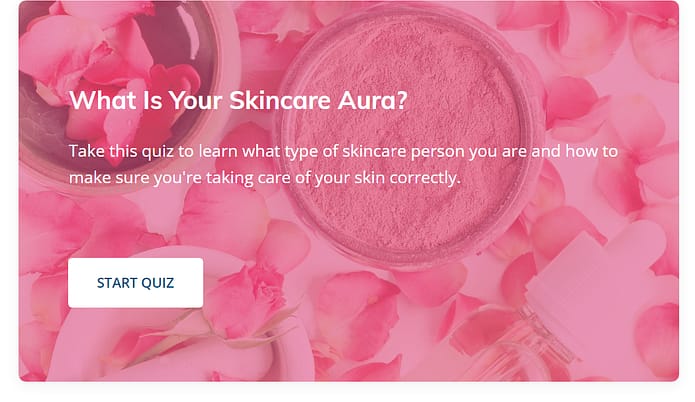
And one word of caution: don't make the quiz feel like an interrogation. Keep it fun, lighthearted, and focused on providing value to the user.
Thrive Tip: Use this detailed guide to learn how to create a personality quiz and add it to your website to increase conversions and engagement.
4. Embed Targeted Forms on Specific Blog Posts to Capture Interested Readers
Your blog posts are prime real estate for lead generation. If someone’s spending time reading a post, it means there’s a high chance they’ll be willing to exchange their email address for a relevant offer.
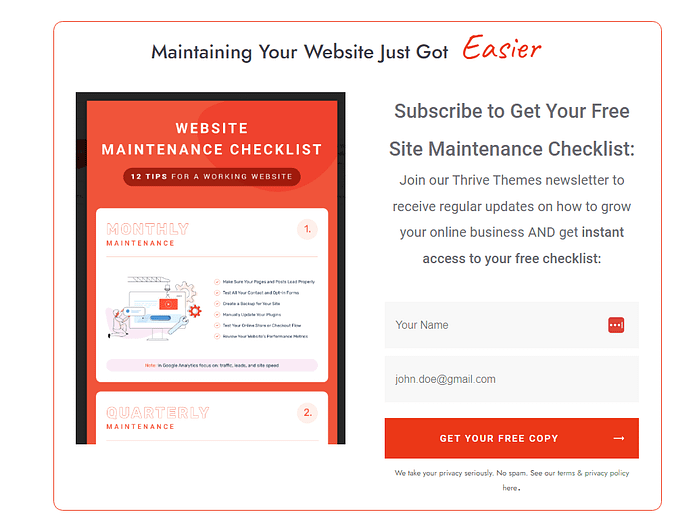
An example of a targeted opt-in form found at the end of a blog post based on the same topic, giving readers the chance to download an easy-to-follow checklist to maintain their websites.
Let’s say someone is reading one of your blog posts, “How to Learn SEO and Become a Pro” for example. If you show them a signup form for a free guide on beginner tips, it matches their current interest perfectly, making them more likely to sign up.
This is where a marketing tool like Thrive Leads can make a big difference. It's built to make the task of creating and placing opt-in forms straightforward, saving you both time and effort.
For a given form, you can program the display logic to show it across your site or on specific posts and pages.
Because the display logic in Thrive Leads is so comprehensive, you can make sure you pair the right opt-in offer with the most relevant content to help grow your email list in the shortest time possible.
5. Use Social Proof Early to Establish Trust
Before anyone reads your headline, they’re already making silent judgments: Does this look legit? Have other people trusted them? Will this waste my time?
That’s why light-touch social proof is your best friend in the Awareness stage. No long-winded testimonials. No emotional customer case studies (yet). Just simple, quiet signals that say: “You're in the right place.”

Adding Testimonials in Thrive Architect
It might seem minor, but it works. One study found that testimonials can boost conversions by 34%, and half of consumers say trust badges make them feel safer on a site.
So don’t overthink it. Just make it obvious that real people trust you. That tiny bit of reassurance could be what keeps a visitor from bouncing in the first 5 seconds.
🧐 Consideration Stage: Build Momentum and Trust
Once someone lands in your funnel, they need to feel like they’re in the right place. These tips help build curiosity, credibility, and clarity.
6. Add a Chatbot for Instant Support
Patience is in short supply when people are browsing online. I've seen potential customers vanish because they couldn't get quick answers to their questions.
But if you’re a small business owner with limited resources, you won’t always be able to answer your prospects’ queries on time. What do you do?
Enter chatbots - the 24/7 support staff that never sleeps. Adding one to your funnel can significantly boost your conversion rates – and give you more time to focus on other parts of your business.
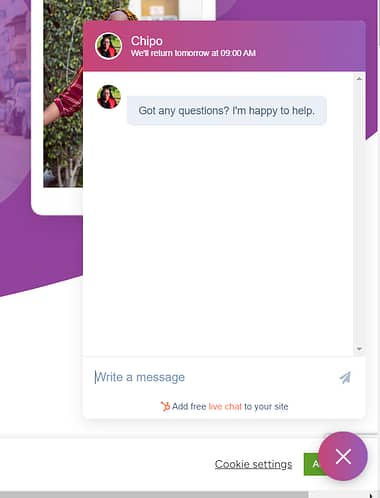
Example of a chatbot on a Thrive Architect-built site.
Here's why chatbots work so well:
- They provide instant answers, keeping visitors engaged and moving through your funnel.
- They can qualify leads by asking the right questions.
- They're available round the clock, catering to customers in different time zones.
- They can handle multiple conversations simultaneously, making it easier to resolve several customer issues at the same time.
But a word of caution: don't try to pass off your chatbot as a human. Be upfront about it being an AI assistant. In my experience, people appreciate honesty and are often impressed by a well-designed bot.
7. Use Conditional Display to Target the Right Visitors
Conditional display lets you dynamically adjust your funnel pages’ content based on specific criteria.
It might be the visitor's location, the device they're using, their referral source, or their previous interactions with your site. The result? A personalized experience that resonates more deeply with each individual.
The beauty of this tool is its versatility. You can use it to alter headlines, swap out images, change call-to-action buttons, or even modify entire sections of your page. With this flexibility, you can easily create a funnel that feels tailor-made for each visitor.
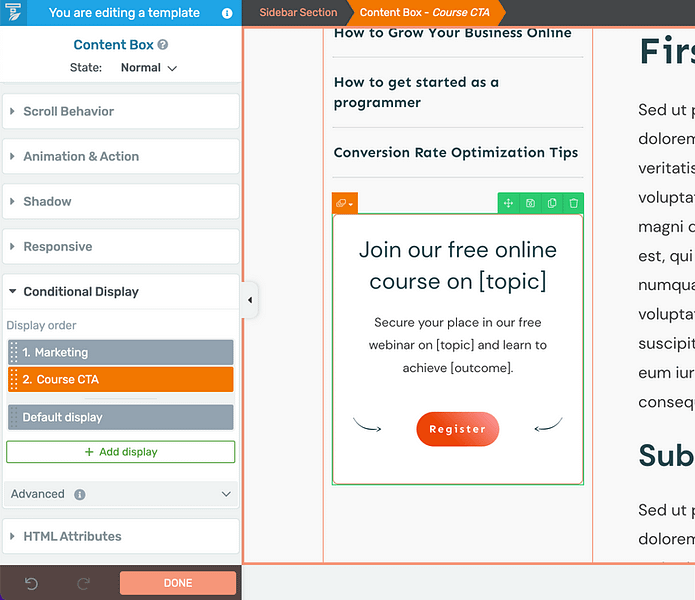
Conditional Display in Thrive Architect
For example, let's say you run an online fitness coaching business. A visitor arrives at your landing page after clicking an ad about weight loss. With conditional display, you can automatically adjust your page to focus on weight loss content.
Your headline could change from "Get Fit with Personal Coaching" to "Lose Weight with Expert Guidance". The hero image switches from a general fitness photo to one showing successful weight loss transformations. And you could place testimonials featuring weight loss success stories to really drive the point home.
Before you tweak headlines or images, it’s worth checking your layout against an optimal landing page structure so you’re not guessing at what to include.
Now, if another visitor arrives after clicking an ad about muscle gain, the same page could dynamically change to focus on promoting your bodybuilding offer.
This level of personalization makes your funnel more relevant and compelling to each visitor, which can help increase your conversion rates significantly.
8. Add a Progress Timeline to Your Funnel
When it comes to conversion funnel design, small elements can make a big difference.
Adding a progress timeline to your funnel provides your potential customers with a clear picture of where they are in the process – which is especially useful for complex multi-step funnels.

The goal is to make your funnel feel manageable and transparent. A progress timeline reassures visitors they're on the right track which, in turn, reduces anxiety and increases the likelihood they'll reach your desired conversion point.
It's a straightforward tactic, but one that can have a substantial impact on your funnel's performance.
9. Add Demo Videos to Your Landing Pages
Demo videos serve multiple purposes.
They quickly communicate your value proposition, show your product in action, and build trust with potential customers. In just a minute or two, visitors can gain a clear understanding of what you're offering and how it can benefit them.

Placement is key. Position your video prominently above the fold where it's immediately visible. Auto-play can be effective, but always include a mute option to respect your visitors’ preferences.
Keep your demo video concise and engaging. Aim for 60-90 seconds - long enough to convey key information, but short enough to maintain attention. Focus on highlighting the most important features and benefits, and include a clear call-to-action at the end.
Quality matters. A poorly produced video can undermine your credibility. Invest in professional production if possible, or at least ensure your DIY video has clear audio and visuals.
Thrive Tip: Want to learn how to create video sales pages that convert? Check out this handy guide.
10. Offer a Risk-Free Free Trial
Free trials allow potential customers to experience your product or service firsthand, reducing the perceived risk of making a purchase.
When you offer a risk-free trial, you're demonstrating confidence in your offering. It tells customers, "We believe you'll love this so much, we're willing to let you try it for free." This can be particularly effective for subscription-based services or software products.
When implementing a free trial, be clear about the terms. Specify the duration, what features are included, and any limitations. Transparency builds trust and sets appropriate expectations.

Consider offering a "frictionless" trial that doesn't require credit card information upfront. This can significantly increase trial sign-ups, as it removes a major barrier to entry for many potential customers.
However, here's a crucial caveat: make sure you have a solid email campaign in place. A free trial is just the beginning. You need a well-crafted series of emails to guide users through your product, highlight key features, and ultimately convert them into paying customers.
Your email campaign should educate, engage, and gently nudge users towards conversion. Include tutorials, case studies, and timely reminders as the trial period nears its end.
11. Reinforce Trust with Stronger Proof During Evaluation (Part 2)
At this point, your visitors aren’t just window shopping anymore—they’re leaning in. Reading your offer. Hovering over the pricing button. Maybe even bookmarking the page (if that’s still a thing).
But interest doesn’t always equal action—especially if there’s even a hint of hesitation. That’s where stronger social proof steps in. This is your moment to say, “Don’t just take our word for it…”
Bring out the big guns:
- Detailed testimonials with names, faces, and real results
- Case studies that show before-and-after impact
- User-generated content like review videos, social shares, or tagged posts
- Expert endorsements if someone credible has your back
This isn’t just for show. Stats say nearly 95% of consumers read online reviews before making a purchase.
Think of this stage like dating: they’re into you, but they’re still quietly Googling your red flags. Don’t give them a reason to ghost.
Place your best proof near key decision points — next to pricing, below CTAs, or anywhere doubt might creep in. Show them other people made the leap — and are better for it.
💸 Decision Stage: Drive Action When It Matters Most
At this point, the right message (or the right nudge) can make all the difference. These strategies help overcome hesitation and boost conversions.
12. Introduce a Downsell Offer Before Someone Exits
Not every visitor is ready for your main offer. But that doesn't mean they're a lost cause. The downsell is a powerful sales technique that helps you capture value from visitors who might otherwise leave empty-handed. Some refer to this method as “saving a sale”.
A downsell is a lower-priced alternative you present when someone's about to exit your funnel without purchasing. It's your last chance to convert a hesitant visitor into a customer.

Your downsell should be related to your main offer but more accessible. It could be a stripped-down version of your product, a lower-tier service, or an inexpensive tripwire to get them into your ecosystem.
Frame it as a special opportunity. "Before you go, here's a special offer just for you..." That way, you’ll create a sense of exclusivity that’s hard to resist.
13. Create Time-Scarcity Campaigns to Drive Action
Nothing motivates action like a ticking clock.
Time-scarcity campaigns tap into a fundamental aspect of human psychology: our fear of missing out. When we know an opportunity is limited, we're more likely to take action. It's why "limited time offers" and "while supplies last" are such powerful marketing phrases.

When you add a time limit to your offers, you create a sense of urgency that can significantly increase conversions. Customers who might have otherwise procrastinated or forgotten about your offer are motivated to act now. This urgency bypasses the rational, often over-analytical part of our brains and appeals directly to our emotions and instincts.
For you, as a business owner, this means more sales in a shorter period.
🔁 Post-Purchase Stage: Don’t Stop at the Sale
The real growth comes after the purchase. These strategies help turn one-time buyers into loyal fans.
14. Optimize Your Post-Purchase Funnel Experience
You've made a sale - congratulations! But don't stop there. What you do after a customer buys can make or break your small business.
Your thank you page is your first chance to make a great post-purchase impression. Don't just throw in a generic "thanks for your order." Get personal. Include a short video of yourself thanking the customer. Or provide quick tips on how to use what they just bought. This personal touch can set you apart from bigger competitors.
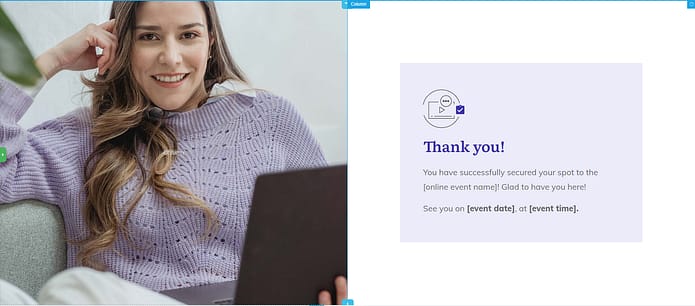
Thank You page block in Thrive Architect
After a sale, ask your customers a few quick questions. What made them choose your product? What are they hoping to achieve with it? This info is invaluable - it helps you understand your customers better and improve what you offer.
Don't shy away from suggesting additional products, but be smart about it. If someone buys a power tool from your hardware store, maybe recommend safety gear or accessories that complement it.
Every interaction after a purchase is a chance to build a stronger relationship. Share usage tips, ask for feedback, or simply check in to see how they're enjoying the product.
These small gestures can turn one-time buyers into loyal fans who'll spread the word about your business.
4 Common Funnel Conversion Mistakes to Avoid
Optimizing your funnel isn’t just about what you do — it’s very much about what you *stop* doing. These four mistakes quietly kill funnel performance and show up again and again when we audit client funnels:
1. Ignoring the Mobile Experience
More than 60% of all web traffic comes from mobile, so a clunky mobile funnel is an instant conversion killer.
Make sure your pages load in under three seconds, forms are thumb-friendly, and your layout doesn’t break on smaller screens.
If improving mobile UX is a priority, Thrive Architect + Smart Landing Pages makes this quick work.
2. Overcomplicating the Process
Every extra field, extra step, extra sentence = extra friction.
Users should always feel like the next step is obvious, simple, and safe. If it’s not essential, remove it.
3. Not Tracking Micro-Conversions
Focusing only on final sales means you're missing the full story.
Track micro-conversions like:
Micro-conversion data helps you see exactly where people hesitate — long before they disappear entirely.
If you’re using Thrive Suite, Thrive Optimize makes micro-conversion testing easy.
4. Neglecting the Post-Purchase Funnel
The funnel doesn’t end at the sale.
A confusing onboarding, a dead-end confirmation page, or zero follow-up emails will tank your customer lifetime value (CLV).
Use this stage to:
A strong post-purchase funnel is one of the easiest ways to multiply revenue without increasing acquisition costs.
Next Steps: Set Up Analytics and Testing To Track Your Funnel’s Progress
As I mentioned earlier, the first step to analyzing your funnel’s performance starts with reviewing your analytics.
Your site's analytics are the foundation for understanding how well your funnel is performing. They hold all the key information you need to identify problem areas and opportunities for improvement.
Now, if you’re new to Google Analytics, you might find the platform a little confusing. That’s why I recommend using a tool like MonsterInsights or ExactMetrics to track your sales funnel metrics in a way that’s easy to understand.
You can also take a look at this step-by-step guide to learn how to set up analytics on your WordPress website.
💬 Frequently Asked Questions
It depends on your industry and offer, but most funnels fall within these benchmarks:
- Visitor → Lead: 1%–5%
- Lead → MQL: 25%–35%
- MQL → SQL: 13%–26%
- SQL → Opportunity: 50%–62%
- Opportunity → Customer: 15%–30% If you’re far below these ranges at any stage, that’s the first place to optimize.
Wrapping Up: How to Improve Your Funnel Conversion Rates
So, by now you should be able to see that improving your funnel conversion rates isn’t about piling on more tactics or obsessing over microcopy. It’s about fixing what’s actually broken at the exact stage where people are bailing.
Most funnels fail not because of bad ideas, but because they’re trying to solve the wrong problem at the wrong stage.
So here's your move:
- Stop assuming it’s your CTA text.
- Start figuring out if people even get to your CTA in the first place.
- Don’t just make your page prettier.
- Make it work harder with data, intention, and a clear customer journey.
In fact, here are a few tutorials to help make sure you’ve built your funnels the right way:
- How to Build Your First Sales Page on WordPress
- How to Build a Complete Sales Funnel (Simple Guide)
- 13 Copywriting Tips for Beginners (How to Write Like a Pro)
- How to Boost Your Call-to-Action Click-Through Rates (9 Hacks)
Your funnel should be a smooth slide, not an obstacle course. And now you’ve got everything you need to make that happen, from attracting the right people to keeping them coming back.
So ask yourself:
Where are they ghosting you—and what are you going to fix first?
And when you’re ready to build a funnel that actually converts (without duct tape and guesswork), Thrive Architect has your back.
Here's to your success!

